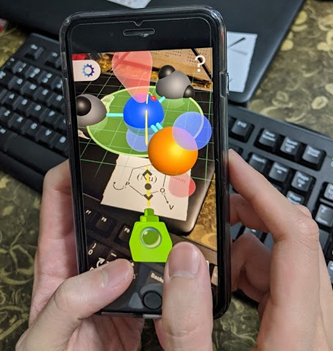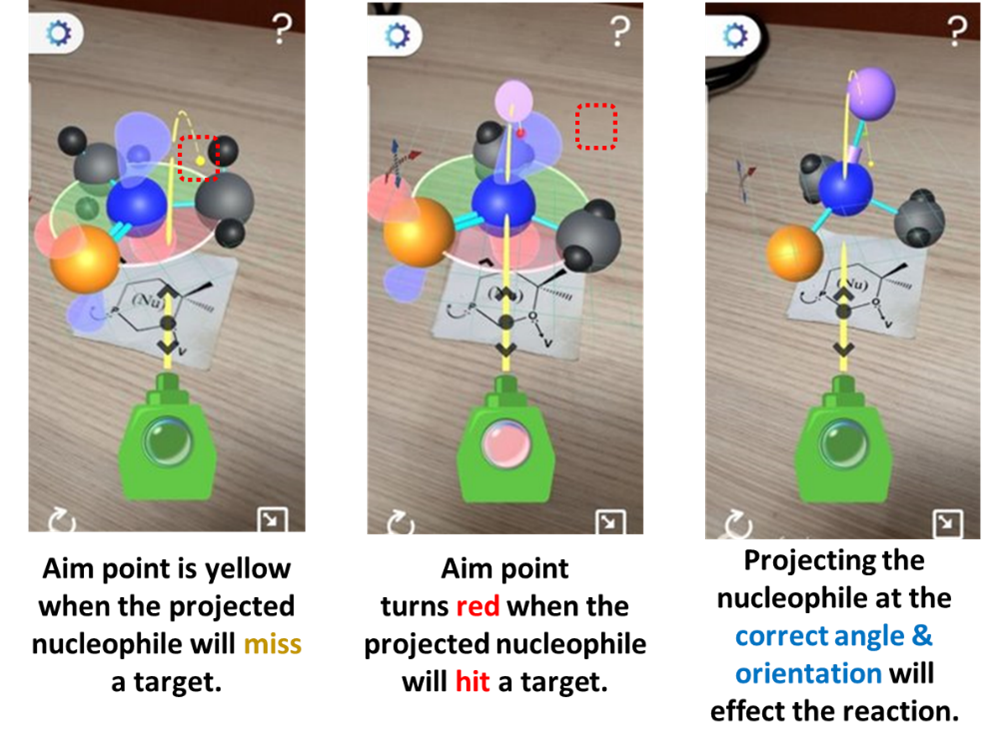Interactive Augmented Reality (AR) app NuPOV could be the answer to teach undergraduates Organic Chemistry Reactions.
The topic “Organic Chemistry” may strike fear in many students taking a course in chemistry, and rightfully so as organic chemistry is considered one of the most challenging branches of chemistry. One reason could be that organic chemistry contains many spatial-visual elements to illustrate concepts such as reaction mechanisms and stereochemistry. Traditionally, such concepts are taught in 2D media like pen and paper (Figure 1). Thus, educators find teaching such concepts challenging to students, and students, especially those with poorer spatial-visual skills, struggle to grasp and understand them.

Figure 1: 2D visualisation of nucleophilic addition, one of the fundamental organic reaction mechanisms. Can you visualise this in 3D in your head?
As chemistry educators at National University of Singapore (NUS), we faced the same problem of teaching organic chemistry to undergraduates. We felt that a different approach was needed to help our students to improve their spatial-visual skills, and to enable them to have the confidence to tackle questions that requires spatial visualisations. After doing research and experimentations, we decided to leverage on AR technology to help students to build their confidence in their understanding and answering questions that require spatial visualisations.
Using AR technology to visualise 3D chemical structures is not new. As development of AR technology is rapid, with many modern-day smartphones possessing the capability to render AR, its use by consumers has been ubiquitous. A number of educators have developed mobile applications based on AR to visualise 3D molecular structures. However, most of these applications lacked user-interactivity which is crucial in allowing students to better grasp the spatial-visual aspect of chemistry.
The Creation of NuPOV
To address those limitations, we partnered with programmers and technologists at NUS Information Technology department to develop our own mobile application that is targeted towards our freshman organic chemistry students majoring in chemistry. Our mobile application focuses on nucleophilic addition as this reaction mechanism is the universally fundamental concept for organic chemistry. The goals of the application were to allow students to understand the requirements needed for a successful reaction between the target specie (electrophile) and attacking specie (nucleophile), and observe how the shape of the electrophile changes as the reaction proceeds. We were concerned on how to implement user-interactivity into our mobile application so that students can learn nucleophilic addition in a fun way. Taking inspiration from many “shoot ‘em-up” games, we implemented a way to allow users to “fire” nucleophile onto the electrophile using a cannon (Figure 2). Thus, Nucleophile’s Point of View (NuPOV) was born.

Figure 2. NuPOV in action. Here, a student aims the green cannon at the electrophile in preparation to shoot it with nucleophile.
Gameplay of NuPOV
To start using NuPOV, users download NuPOV from the respective smartphone OS’s app store. After downloading the application, users launch NuPOV and scan the AR marker (Figure 3) to initialise the 3D structure of the electrophile. The user then look from the point of view of the nucleophile (hence the name Nucleophile’s Point of View) and decide which angle and orientation to attack the electrophile based on Collision Theory to elicit a successful reaction. This is achieved by having the user to aim the green cannon at the electrophile and fire the nucleophile towards the electrophile using their fingers. If the reaction is successful, the user is able to observe how the shape of the electrophile changes to give the final product (Figure 4).

Figure 3. The NuPOV AR marker to initiate the electrophile

Figure 4. The gameplay of NuPOV, showing the aiming and firing of nucleophile towards electrophile
The Benefits of NuPOV
What sets our NuPOV different from the other AR chemistry applications available in the market are that the use of the mechanistic and interactive approach of firing nucleophile towards the electrophile allows students to observe how the molecules change during a successful reaction in 3D. In addition, it also enables students to learn about the physical and spatial factors such as angle of attack that are required to elicit the reaction in a fun and engaging way. NuPOV also promotes self-directed learning as it allows students to clarify their doubts on their understanding of nucleophilic addition quickly through individualised interactive experience of the application. In fact, when we tried NuPOV with our freshman organic chemistry students and get them to do a survey on their experience with NuPOV, they reported feeling more confident solving tougher questions related to nucleophilic addition. Furthermore, they also reported that they are more confident in their understanding enough in the topic to teach their peers.
The Future of NuPOV
NuPOV has great potential in teaching spatial visualisation in organic chemistry, has been well-received by students. We hope to further improve NuPOV by expanding our library of electrophiles by adding more complex molecules, and other reaction mechanisms such as nucleophilic substitution (SN1).
About the author: Fun Man is a Singaporean lecturer in Learning Sciences and Chemistry at the National University of Singapore. He was conferred the prestigious University Annual Teaching Excellence Award in 2017 and NUS Faculty Teaching Excellence Award 2016. He is a distinguished recipient of the D2L award Innovation in Teaching and Learning (2019) and QS-Wharton STAR Reimagine Education Awards (2017, 2018) for his effort in innovative teaching and learning approach. He was the Singaporean representative for Global Young Scientists Summit 2020, and a member of the CAS Future Leaders Program 2020, selected by the American Chemical Society.

Author
Dr. Fun Man FUNG
National University of Singapore














